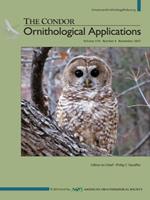Songbirds are under strong pressure to choose nest locations that reduce the risk of nest predation and, as such, are expected to use a variety of information sources to guide decisions about nest sites. The activity patterns of potential predators in the local vicinity should be one especially important source of information, although this may vary in urban ecosystems with altered predator–prey relationships. We examined the extent to which predator activity was associated with the nest distribution and survival of Northern Cardinals (Cardinalis cardinalis) and Acadian Flycatchers (Empidonax virescens) in 13 riparian forests situated across a gradient of urbanization in central Ohio, USA, in 2008–2010. We focused on a suite of diurnal predators that was responsible for >70% of songbird nest depredations in our study system. By overlaying nest locations of cardinals (n = 334) and flycatchers (n = 60) on predator utilization distributions created from mapped predator locations at each site, we determined the corresponding probability of predator use for each site, year, and nest location. The amount of urbanization surrounding sites did not predict nest survival nor relationships between nest placement and nest predator activity. Instead, predator activity better explained patterns of nest distribution and survival. Cardinals nested in areas of high use by avian predators (especially Brown-headed Cowbird (Molothrus ater)), but nest survival only declined when these areas also received high use by mammalian predators. The distribution of flycatcher nests was unrelated to predator activity, but nest survival declined where avian predator activity was high and mammalian predator activity was low. Although predator movements at local scales predicted nest survival, our findings provided no evidence that cardinals and flycatchers used that information to select nest sites. Further examination of spatiotemporal variation in the use of predator cues by breeding songbirds is needed to elucidate patterns of information use in songbird nest-site selection, particularly in urban ecosystems.
How to translate text using browser tools
27 September 2017
Does nest predator activity predict the location and survival of songbird nests in urbanizing landscapes?
Laura J Kearns,
Amanda D Rodewald
ACCESS THE FULL ARTICLE

The Condor
Vol. 119 • No. 4
November 2017
Vol. 119 • No. 4
November 2017
nest location
nest survival
predator
songbird
urbanization
utilization distribution




